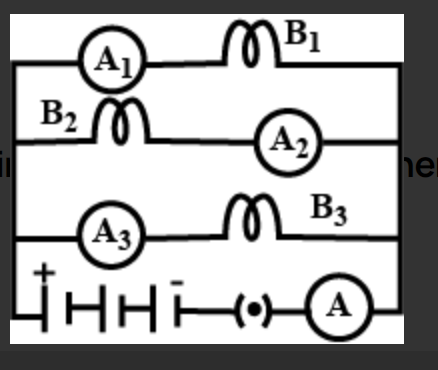
What happens to the reading $ A_1,A_2,A_3 $ and $ A $ when the bulb $ B_2 $ gets fused?

$ \left( A \right)A_1 = 1A,A_2 = 0A,A_3 = 0AandA = 2A \\
\left( B \right)A_1 = 1A,A_2 = 0A,A_3 = 1AandA = 2A \\
\left( C \right)A_1 = 2A,A_2 = 0A,A_3 = 1AandA = 2A \\
\left( D \right)A_1 = 1A,A_2 = 0A,A_3 = 1AandA = 1A \\ $

Answer
526.5k+ views
Hint :In order to solve this question, we are going to take the voltage and the current, and then find the total resistance for the circuit, then considering the case when the bulb $ B_2 $ gets fused, we can find the corresponding resistance and the voltage. And finally the ampere readings are found.
In the parallel setup of resistances, the total resistance for all the resistors is given by $ \dfrac{1}{R} = \dfrac{1}{{R_1}} + \dfrac{1}{{R_2}} + \dfrac{1}{{R_3}} $
Here, all the bulbs are same so they have the same values of resistances, so, $ R_1 = R_2 = R_3 = R $
Complete Step By Step Answer:
The total resistance will be $ R' = \dfrac{R}{3} $
Now as we know that according to ohm’s law
$ V = IR $
Where $ V $ is the voltage, $ I $ is the current and $ R $ is the resistance of the circuit
In this case, the voltage is given as $ 4.5V $ and the current across the resistances is $ 3A $
Substituting this information in the formula, we get
$ 4.5 = 3 \times \dfrac{R}{3} \\
\Rightarrow R = 4.5\Omega \\ $
But as the bulb $ B_2 $ gets fused, only two bulbs will remain connected in parallel
Therefore, the resultant resistance will be
$ \dfrac{1}{{R'}} = \dfrac{1}{{R_1}} + \dfrac{1}{{R_2}} = \dfrac{2}{{4.5}} \\
\Rightarrow R' = \dfrac{{4.5}}{2}\Omega \\ $
So, the current will be equal to
$ I = \dfrac{V}{{R'}} = \dfrac{{2 \times 4.5}}{{4.5}} = 2A $
Since $ B_2 $ gets fused and only $ B_1 $ and $ B_3 $ are parallel and have the same resistance, $ 2A $ current will be equally distributed between them with the currents equal to $ 1A $ to each.
Hence, the ammeter readings will be like where $ A_1 $ shows $ 1A $ , $ A_2 $ shows zero where the bulb $ B_2 $ blows off, $ A_3 $ shows $ 1 $ ampere and $ A $ shows $ 2 $ amperes, the total current in the circuit.
So, option (B) is correct.
Note :
It is important to note that it is given a parallel combination of the resistors and the current from each parallel section will be different while the voltage will be the same for the resistances as given. When bulb $ B_2 $ blows off, the segment will be short circuited and no current will pass through that segment.
In the parallel setup of resistances, the total resistance for all the resistors is given by $ \dfrac{1}{R} = \dfrac{1}{{R_1}} + \dfrac{1}{{R_2}} + \dfrac{1}{{R_3}} $
Here, all the bulbs are same so they have the same values of resistances, so, $ R_1 = R_2 = R_3 = R $
Complete Step By Step Answer:
The total resistance will be $ R' = \dfrac{R}{3} $
Now as we know that according to ohm’s law
$ V = IR $
Where $ V $ is the voltage, $ I $ is the current and $ R $ is the resistance of the circuit
In this case, the voltage is given as $ 4.5V $ and the current across the resistances is $ 3A $
Substituting this information in the formula, we get
$ 4.5 = 3 \times \dfrac{R}{3} \\
\Rightarrow R = 4.5\Omega \\ $
But as the bulb $ B_2 $ gets fused, only two bulbs will remain connected in parallel
Therefore, the resultant resistance will be
$ \dfrac{1}{{R'}} = \dfrac{1}{{R_1}} + \dfrac{1}{{R_2}} = \dfrac{2}{{4.5}} \\
\Rightarrow R' = \dfrac{{4.5}}{2}\Omega \\ $
So, the current will be equal to
$ I = \dfrac{V}{{R'}} = \dfrac{{2 \times 4.5}}{{4.5}} = 2A $
Since $ B_2 $ gets fused and only $ B_1 $ and $ B_3 $ are parallel and have the same resistance, $ 2A $ current will be equally distributed between them with the currents equal to $ 1A $ to each.
Hence, the ammeter readings will be like where $ A_1 $ shows $ 1A $ , $ A_2 $ shows zero where the bulb $ B_2 $ blows off, $ A_3 $ shows $ 1 $ ampere and $ A $ shows $ 2 $ amperes, the total current in the circuit.
So, option (B) is correct.
Note :
It is important to note that it is given a parallel combination of the resistors and the current from each parallel section will be different while the voltage will be the same for the resistances as given. When bulb $ B_2 $ blows off, the segment will be short circuited and no current will pass through that segment.
Recently Updated Pages
Master Class 12 Business Studies: Engaging Questions & Answers for Success

Master Class 12 Economics: Engaging Questions & Answers for Success

Master Class 12 English: Engaging Questions & Answers for Success

Master Class 12 Maths: Engaging Questions & Answers for Success

Master Class 12 Social Science: Engaging Questions & Answers for Success

Master Class 12 Chemistry: Engaging Questions & Answers for Success

Trending doubts
What are the major means of transport Explain each class 12 social science CBSE

Which are the Top 10 Largest Countries of the World?

Draw a labelled sketch of the human eye class 12 physics CBSE

How much time does it take to bleed after eating p class 12 biology CBSE

Explain sex determination in humans with line diag class 12 biology CBSE

Differentiate between homogeneous and heterogeneous class 12 chemistry CBSE




